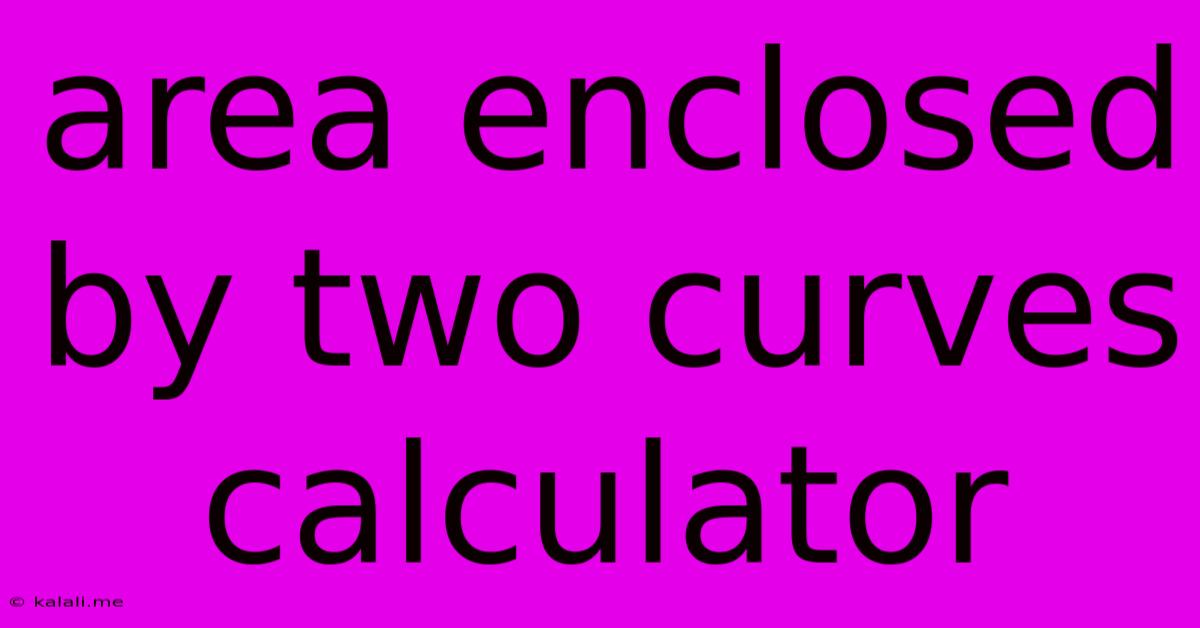Area Enclosed By Two Curves Calculator
Kalali
Jun 13, 2025 · 3 min read

Table of Contents
Area Enclosed by Two Curves Calculator: A Comprehensive Guide
Finding the area enclosed by two curves is a common calculus problem with applications in various fields, from physics and engineering to economics and statistics. While manual calculation can be complex and time-consuming, numerous online calculators and software tools can simplify this process significantly. This article will explore the concept, the underlying mathematical principles, and guide you on effectively using an area enclosed by two curves calculator.
What is an Area Enclosed by Two Curves Calculator?
An area enclosed by two curves calculator is a digital tool that computes the area between two functions, f(x) and g(x), within a specified interval [a, b]. It automates the process of setting up and solving the definite integral required for this calculation. This eliminates the need for manual integration, reducing the risk of errors and saving valuable time. These calculators typically handle a variety of functions, including polynomials, trigonometric functions, exponential functions, and more. Some even offer visualization of the curves and the shaded area they enclose.
Mathematical Principles Behind the Calculation
The core principle behind calculating the area enclosed by two curves lies in definite integration. The area 'A' between two curves f(x) and g(x) from x = a to x = b is given by:
A = ∫[a, b] |f(x) - g(x)| dx
This formula calculates the area between the curves by integrating the absolute difference between the two functions over the specified interval. The absolute value ensures that the area is always positive, regardless of which function is greater within the interval.
How to Use an Area Enclosed by Two Curves Calculator
While the specific interface varies across different calculators, the general process usually involves these steps:
-
Input the functions: Enter the equations of the two curves, f(x) and g(x), accurately. Pay close attention to syntax and use the correct mathematical notation.
-
Specify the interval: Define the limits of integration, 'a' and 'b', representing the x-coordinates where the area calculation begins and ends. These points often correspond to the intersection points of the two curves. Finding these intersection points might require using a separate equation solver or graphing tool beforehand.
-
Select the calculation method (if applicable): Some advanced calculators may offer different integration methods (e.g., numerical integration). Choose the appropriate method based on the complexity of the functions involved.
-
Execute the calculation: Click the "Calculate" or equivalent button to initiate the computation.
-
Interpret the results: The calculator will usually provide the numerical value of the area. Review the result to ensure it's reasonable in the context of the problem. Consider visually inspecting a graph of the functions to confirm the calculated area makes sense.
Choosing the Right Calculator
The best calculator for you will depend on your specific needs and the complexity of your problems. Consider the following factors when making your choice:
- Functionality: Does it handle the types of functions you need to work with?
- Accuracy: How precise are its calculations?
- Ease of use: Is the interface intuitive and easy to navigate?
- Visualization: Does it provide graphical representations of the curves and the area?
Advanced Applications and Considerations
Beyond basic area calculations, some advanced calculators can handle:
- Areas with multiple intersections: Calculators capable of handling areas where curves intersect multiple times are particularly useful.
- Integration techniques: Calculators employing different integration techniques (e.g., numerical methods like Simpson's rule or trapezoidal rule) provide more flexibility when dealing with complex functions.
- Applications in other fields: The principle of calculating areas between curves can be applied to solve problems in various fields like finding the volume of solids of revolution.
In conclusion, an area enclosed by two curves calculator is a powerful tool for anyone needing to efficiently and accurately determine the area between two functions. Understanding the underlying mathematical principles and effectively using these calculators can significantly improve problem-solving efficiency and reduce errors in various applications. Remember to carefully input the functions and interval to ensure accurate results.
Latest Posts
Latest Posts
-
Difference Between Quality Control And Quality Assurance Pdf
Jun 14, 2025
-
Gpa Requirements For University Of Memphis
Jun 14, 2025
-
What Are The Prime Factors Of 156
Jun 14, 2025
-
Which Of The Following Is A Connectionless Protocol
Jun 14, 2025
-
Cooling Of Magma On Earths Surface
Jun 14, 2025
Related Post
Thank you for visiting our website which covers about Area Enclosed By Two Curves Calculator . We hope the information provided has been useful to you. Feel free to contact us if you have any questions or need further assistance. See you next time and don't miss to bookmark.